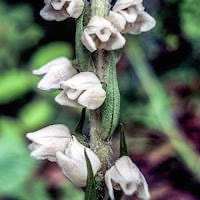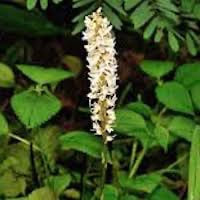WWD8 - Women's Woody 8 - Scandalwood
|
Native Singaporean Orchid notes: Sophrolaeliocattleya Elusive Heartbeat
Sophrolaeliocattleya Elusive Heartbeat is a sought-after orchid renowned for its role in the fragrance "Woody 8 (Women)" used in perfume workshops. This hybrid orchid is admired for its captivating scent and compact size, making it popular in perfumery. Its flowers bloom in lavender to deeper pink/red hues, emitting a sweet and floral aroma. Derived from the Sophronitis species, it inherits vibrant flower colors ranging from yellow-orange to red. Its inclusion enhances the perfume's complexity, offering an elegant and sophisticated olfactory experience appreciated by fragrance enthusiasts worldwide.
|
Therapeutic Orchid notes:
|
Coelogyne occultata Hook. f. syn Pleione occulta (Hook f.) Kuntze
Coelogyne occultata, known as Luanyebeimu Lan or ovate leaf pearl shell orchid in Chinese, is esteemed for its aromatic allure and medicinal benefits in traditional Chinese medicine (TCM). Its fragrance is described as pleasant and floral, enhancing its appeal in perfume blends. In TCM, it is used to nourish yin, benefit the kidneys, and promote bodily fluids production. This orchid treats ailments like hot flushes, fever, backache, and anorexia, reflecting its valued role in herbal remedies across Yunnan and Xizang regions, where it thrives. |
|
Goodyera brachysteia Hand. Mazz
Goodyera brachysteia Hand. Mazz, also known as Short bud spotted leaf orchid, is a unique terrestrial herb native to southwest Guizhou province and adjacent northeast Yunnan, China. Valued for its ornamental beauty and delicate fragrance, this orchid emits a pleasant, slightly sweet scent with subtle floral notes from its flowers and leaves. In Traditional Chinese Medicine (TCM), it is prized for its ability to "strengthen the middle burner and replenish qi," supporting digestive health and energy levels. Used in decoctions, it promotes blood flow, relaxes muscles, and treats ailments like backache, testicular swelling, dizziness, and tinnitus, while also benefiting the waist and kidneys according to TCM practices. |
|
Holcoglossum amesianum (Rchb. f.) Christenson
Holcoglossum amesianum (Rchb. f.) Christenson, known as Dagencaoshe Lan (big slot tongue orchid), Wanda Lan (ten thousand generation orchid), Diao lan (hanging orchid), Jiegucao (bone setting herb) in Chinese, and Moe kadol in Myanmar, is an epiphytic orchid thriving in the shade of limestone rocks. Revered for its enchanting fragrance described as sweet and citrusy with floral notes, it's favored by orchid enthusiasts. In Traditional Chinese Medicine (TCM), known as Jiuzhualong, it serves as an antipyretic to reduce fever, has anti-inflammatory properties, and aids in treating malaria, sore throat, urinary infections, and bone health. Conservation efforts are vital due to habitat loss and illegal collection, threatening its existence despite its cultural and medicinal significance. |
|
Neottia camtschatea (L.) Rchb. f.
Neottia camtschatea, known as Kamchatka bird's nest orchid or Beifangniaochao Lan in Chinese, is a fascinating terrestrial orchid found across northern Chinese provinces, Kazakhstan, and eastern Siberia. It emits a subtle, sweet, and slightly musky fragrance reminiscent of damp earth and decaying leaves, enhancing its natural appeal. In Traditional Chinese Medicine, its root-like stems are used to detoxify the body, removing heat and toxins to promote overall health. Despite its cultural significance and medicinal uses, Neottia camtschatea faces conservation challenges due to habitat loss and over-harvesting, highlighting the need for conservation efforts to protect this unique orchid species. |
|
Nervilia concolor (Blume) Schltr. Syn. Nervilia aragoana Gaud.
Nervilia concolor, also known as the East Asian leaf orchid, is celebrated for its subtle and soothing fragrance across diverse regions from India to Southeast Asia, including Malaysia and Thailand. It holds various Chinese names like Yidianhong and Yidianguang, reflecting its cultural significance and medicinal uses in traditional practices. Valued for its antipyretic and hemostatic properties in Chinese medicine, it is used to treat fever, bleeding, and conditions related to kidney weakness. The orchid's presence in traditional postpartum care in Malaysia and therapeutic applications in Thailand underscores its importance. Despite its cultural and medicinal value, conservation efforts are vital due to threats like habitat loss and over-harvesting, ensuring the preservation of this orchid for future generations. |
|
Peristylis constrictus (Lindl.) Lindl.
Peristylis constrictus, known as "Bhuinora" to the Tanchinga tribe and "Cha-muinda" to the Marma tribe in Bangladesh, and "Dahuakuorui Lan" in Chinese, is a distinctive orchid cherished for its unique fragrance and medicinal uses. Found across diverse habitats from Yunnan in China to Southeast Asia and the Himalayan region, it thrives in elevations of 1500 to 2800 meters. Its earthy aroma, with hints of floral and herbal notes, evokes natural forest scents. Among the Marma tribe, the orchid is used traditionally to create contraceptive pills, highlighting its cultural significance and role in promoting reproductive health. Conservation efforts are crucial due to habitat loss and overharvesting, aiming to preserve this orchid's ecological value and cultural heritage for future generations. |
Other scent note
Scentopia Library Reference ingredient
Kiwi
Download the guided mediation that works best with this Orchid fragrance oil
| women_woody_essential_oil_orchi_00008.mp3 | |
| File Size: | 0 kb |
| File Type: | mp3 |






